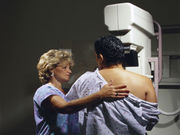DCIS more likely to become invasive at 60 than 50
TUESDAY, Oct. 27, 2015 (HealthDay News) — Ductal carcinoma in situ (DCIS) is much more likely to be aggressive when discovered in older women, according to a report published online Oct. 27 in Radiology.
Stefanie Weigel, M.D., Ph.D., a researcher at University Hospital Muenster in Germany, and colleagues aimed to investigate the link between age at screening and detection rates of the different grades of DCIS. The investigators looked at the medical records of 733,905 women, aged 50 to 69, who were screened with digital mammography between 2005 and 2008. The team looked at DCIS rates for five-year age groups, determining the rate per 1,000 women. They then divided their findings into DCIS of low, intermediate, and high grades.
In all, the investigators found 989 DCIS diagnoses. Of those, 419 were high-grade, 388 were intermediate-grade, and 182 were low-grade. The older the woman, the more likely she was to have a DCIS found, mostly due to an increase in intermediate- or high-grade DCIS. In the group aged 50 to 54, just 1.2 percent had a DCIS finding. By ages 65 to 69, 1.7 percent did.
What is new about this study is the finding about the grades, Weigel told HealthDay. That is important because the higher the grade, the more likely the progression to invasive cancer. “For the most aggressive type, high-grade DCIS, intervals between DCIS detection and the occurrence of invasive carcinoma have been described to be five years, on average,” Weigel said.
Copyright © 2015 HealthDay. All rights reserved.








